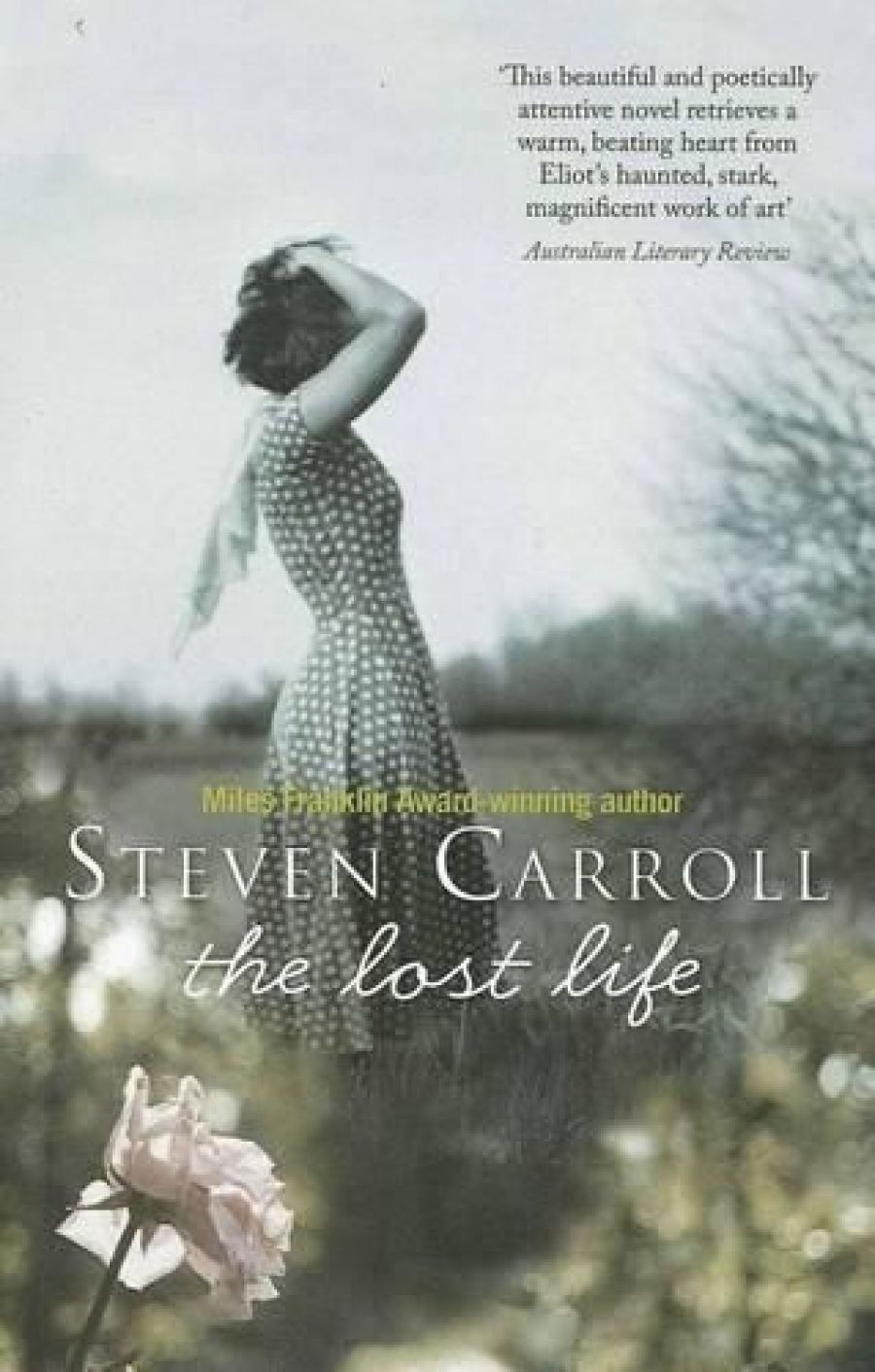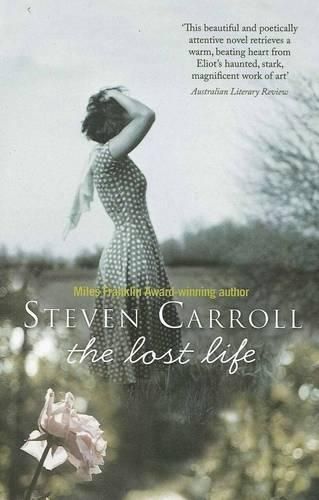
- Free Article: No
- Contents Category: Fiction
- Review Article: Yes
- Article Title: From suburbia to Burnt Norton
- Online Only: No
- Custom Highlight Text:
Midway through Steven Carroll’s beautiful and sombre novel The Lost Life, Emily Hale gives Catherine a pair of French stockings which she has decided she cannot herself wear. To Catherine, who is eighteen, ‘The thought of Miss Hale even buying them, let alone contemplating wearing them, is intriguing, for it opens up the possibility that there may be another side, many other sides, to Miss Hale altogether.’ One of the feats of Carroll’s storytelling is his capacity relentlessly but gently to prod his characters’ inner complexities – their many other sides. Somehow he slows time almost to a standstill, leaving the past and the future pressed hard up against elongated snapshots of the present. He hones in on incidents which often seem quite ordinary, transforming them into monuments to life’s ups and downs. It should be boring, but it’s thrilling.
- Book 1 Title: The Lost Life
- Book 1 Biblio: Fourth Estate, $29.99 pb, 244 pp
- Book 1 Cover Small (400 x 600):

- Book 1 Cover (800 x 1200):

By setting The Lost Life in the Cotswolds, in 1934, Carroll has dramatically shifted time and place from his previous novel, The Time We Have Taken (winner of the 2008 Miles Franklin Award). Following The Art of the Engine Driver (2001) and The Gift of Speed (2004), The Time We Have Taken completed Carroll’s memorable trilogy about the ebb and flow of life in outer suburban Melbourne. While each book in the trilogy stands as an independent work, it is perhaps best to think of the three novels as elements of a greater whole. In tracking the mixed blessing of ‘Progress’ from the 1950s to the 1970s, they collectively represent a major contribution to Australian literature.
By comparison, The Lost Life is a more modest achievement. Still, it is a fine work, an empathetic but edgy interrogation of first loves and lost loves, memory, the echoing effects of lies, bad decisions and personal violations, the nature of fame, and ‘the curious sense of triumph and power that comes with doing other people’s living for them’. Carroll’s prose has a sublime rhythmic quality – it is lyrical and precise, almost as if he has sung words onto the page.
In the key opening scene, Catherine and Daniel, a young couple flush with the excitement of first love, walk to an unoccupied manor house called Burnt Norton in search of rumoured swimming holes. Instead, they find themselves spying on a middle-aged couple – Americans Tom and Emily – who conduct an odd ceremony and then bury a tin in a garden bed. Daniel, who is prone to mischievousness, performs a prank which – in trademark Carroll fashion – reverberates in disquieting and ultimately surprising ways throughout the story.
The ‘Tom’ whom Catherine and Daniel observe in the garden is T.S. Eliot. In The Lost Life’s evocative opening pages, Carroll weaves the themes and imagery of Eliot’s long poem ‘Burnt Norton’, which became the first part of Four Quartets (1943), into his own descriptions of the gardens. In Eliot’s poem, ‘the pool was filled with water out of sunlight’; for Carroll, ‘Bright sunlight ... fills the concrete pool and they stand for a moment, speechless, transfixed by the glare. It is dazzling, but they are drawn into the intense, white reflection, struck motionless by its blinding light. Then a small cloud passes over and the pool is as drained of light as it is of water.’
The Lost Life draws inspiration, in broad strokes at least, from Eliot’s real-life relationship with Emily Hale: they seemingly fell in love in Boston before World War I (precise details are sketchy), but the young Eliot subsequently left for England and ultimately made his home there. They met again and together visited Burnt Norton some twenty years later – possibly, as in Carroll’s fictional version, in September 1934 (see Lyndall Gordon’s T.S. Eliot: An Imperfect Life, 1998) – at a time when Eliot was deeply troubled by his failed marriage to Vivienne and by her unwillingness to accept a separation. Carroll uses these biographical details to create a new and imaginary tale. It is not necessary to be an Eliot aficionado to appreciate the raw emotions that Carroll evokes by entangling the fresh, ardent Catherine and Daniel with the harried, fearful Tom and Emily.
Carroll’s Eliot is a man of contrasts. Daniel and his Cambridge mates have dubbed him ‘Westminster Abbey on legs’. But behind the façade of the living public monument, the famous poet, Eliot feels haunted, and not only by his wife: ‘cattle unnerve him almost as much as humanity does.’ But as Catherine witnesses, he is also capable of a booming laugh so genuine that she feels it must come from a man of true warmth. Eliot makes for an intriguing contrast with Daniel, who has returned from Cambridge having picked up what his father calls ‘bad habits’ – he is a Marxist. Despite unexpectedly falling in love with Catherine’s mind as well as her body, Daniel is readying himself to move to France to learn how to think properly.
While Eliot casts a long and heavy shadow, the core of The Lost Life is the relationship that develops between Catherine and Emily (although it is a very different scenario, it brings to mind Carroll’s wonderfully nuanced portrait of the burgeoning friendship between Rita and Mrs Webster in The Time We Have Taken). Miss Hale, as Catherine calls her, is a drama teacher in the United States, and Catherine is attracted to the idea of being one of ‘her girls’. But a visceral awkwardness builds, especially once Miss Hale, despairing at the prospect of losing Eliot for a second time, enlists Catherine to the cause of warning off Vivienne.
Catherine sets out to grab hold of life’s ‘felt experiences’, starting by properly consummating her relationship with Daniel: ‘No tumble in a sheep paddock for her.’ In contrast, Miss Hale tells Catherine that she and Eliot share an entirely different kind of love, one ‘that is above certain things, like adoring eyes and touch and kisses’, but there is more than a tinge of dissatisfaction, defensiveness and envy in her explanation. The final encounter between the two women is excruciating and almost brutal.
There is a melancholic power to The Lost Life, but also enough sparkle and wit to stop the whole thing from becoming maudlin. But while Carroll writes with characteristic restraint, just occasionally there is a slight thinness or imbalance. At certain times, Eliot and especially Daniel seem like props designed to help create fissures between Catherine and Emily. The brief glimpse of Vivienne is unsettling but a little unsatisfying. Despite these minor quibbles, for the most part there is potency in Carroll’s brevity.
At the end of the book, the story leaps forward sixty years, reinforcing the sense that the past is always ready to crowd in on the present, or, as Eliot put it in ‘Burnt Norton’, ‘Time past and time future / What might have been and what has been / Point to one end, which is always present.’ An elderly Catherine, in the latter stages of what has turned into a spectacular and very public life, finds herself back in the grounds of Burnt Norton. This affords her the chance to reflect on those earlier days, to memorialise and compartmentalise, but it also provides her with an opportunity to right a wrong. It is a measure of the gracefulness of Carroll’s prose that this coda does not come across as too neat and tidy.


Comments powered by CComment